אסי משולם Assi Meshullam
כל המתנות All The Gifts
פתיחה: 3.9.2020 | נעילה: 2.1.2021
האל דיוניסוס, החובש מסכה ומייצג שִכרוּת, העדר שליטה, פראות, אקסטזה וקתרזיס, פטרונם של הקוצרים המסמן בתולדות האמנות פורקן והתעוררות, הוא ציר מרכזי בתערוכת כל המתנות.
סמליו של דיוניסוס, ענבים ומסכה, מתערבים בפסלים המוצבים בגלריה. משולם יוצר באמצעותם עולם פסאודו-ארכיאולוגי מתוך “פעולה דיוניסית”, המונגדת בפילוסופיה עם “פעולות אפולוניות”, שבהן שולטים המיתון והעידון של רגשות ודחפים. בתערוכה מוצגים יצורים היברידיים, פסלונים, לוחות ואובייקטים לצד ספר המשלים שכתב משולם. הספר והיצירות נוצרו ביחד, כגוף אחד, למען תערוכת כל המתנות, והם קשורים זה לזה ביחסי גומלין.
הדמות המפוסלת הנושאת אמפורה חיטים וצמח קיסוס מהווה חוליה מקשרת המצביעה על קווי דמיון בין ההיבטים הדיוניסיים בתערוכה לבין האופי החקלאי של החגים שבועות וסוכות. במיוחד ניכר הקשר בין התהלוכות הדיוניסיות לתהלוכת הלולבים בסוכות, ותהלוכת הביכורים בשבועות, בימים שבהם עמד בית המקדש על מכונו. בתהלוכות האביב היהודיות והדיוניסיות, נישאו סלי ביכורי פירות וירקות שהועלו כקורבן, ופר שקרניו מעוטרות בזהב ובעלי זית צעד בראש התהלוכות. בתהלוכת הלולבים, נישאו ארבעת המינים שבהם בלט הלולב, בדומה ל”תירסוס”, מעין מטה/שרביט שזור בקיסוס ובעלי גפן שאצטרובל מחובר אל קצהו, שבו אחזו משתתפי התהלוכה הדיוניסית.
מלבד פולחן דיוניסוס, מתקשרות המסכות שעוטות הדמויות המפוסלות גם לפולחן עתיק ומצמרר של הקרבת ילדים למולך, שהתרחש באתר פולחני בקרתגו, המושבה הפיניקית (כיום תוניסיה). באתר התגלו מסכות ולצדן כתובות הקדשה לאלים שעבורם הוקרבו הילדים: “כי שמע קולו וברך אותו”.
מוטיב ההתחפשות, המגולם בתערוכה במסכות, קשור גם לאופן העבודה של משולם – המפסל על גבי שלדי בובות של ברבי ובן זוגה קן, צעצועי פלסטיק בצורת חיות ועופות, המשמשים כדחלילים, ופסלי גינה דמויי אבן. בובות הברבי, שנהפכו תחת ידיו של משולם לצלמיות נשיות כמו אלו שנמצאו בשטחי ממלכות ישראל ויהודה הקדומות, מטשטשות את הגבול בין קטגוריות של קיטש, אובייקט נחות וזול, לבין אובייקט שנועד לציין קדושה, פוריות, מזל וברכה. כך מייצר משולם רליגיוזיות חלופית אישית, השואבת מארכיטיפים קדומים. לב העניין לגביו, הוא המפגש בין המשפחה, השגרה היום יומית, לבין החגיגי והפולחני.
ספר המשלים כתוב בסגנון קנוני, כמו המשלים התנ”כיים, משלי ישו בברית החדשה ואף משלי איזופוס. המשלים נסבים על אנשים, חיות ועופות, והם מסופרים בסגנון פנטסטי. ביניהם: משל העכבישונים, משל החור ומשל הילד העיוור, המגולם בתערוכה כפסל שעיניו מתגלגלות כלפי מעלה, ומבטו כאילו פונה כלפי פנים. בניגוד למשלים בכתבי הקודש, הנמשלים אינם מתבקשים מהסיפורים, והמבקרים מוזמנים להתכנס בתערוכה ולדון במשמעויותיהם של משלי משולם. בשנת 2005 כתב משולם את רועכם, ספר שבו חיבר בין האינטלקט לדחפים החייתיים, ובעקבותיו נכתבו פרשנויותיו. ספר זה מהווה בסיס לכינוסים ולדיונים שמוביל משולם.
שם התערוכה, כל המתנות, מתייחס לתוכנה של תיבת פנדורה, שעליה היתה מופקדת פנדורה המיתולוגית, שהמשמעות המילולית של שמה היא “כל” (פַּנ-) ו”מתנות” (דוֹרוֹן, ביוונית ובעברית כאחד, היא מתנה). פנדורה לא צייתה להוראתו של זאוס להשאיר את התיבה נעולה; בפותחהּ את התיבה, שחררה לעולם את כל הצרות והפורענויות הפוקדות את המין האנושי מאז ועד עתה. כל המתנות מרמז גם למנחות לאלים, שנתפסו בעולם הקדם כמתנות שנותנים בני האדם לאלוהיהם.
אוצרת: שירה פרידמן
The god Dionysus, who wears a mask, represents intoxication, loss of control, wildness, ecstasy and catharsis. This patron of harvesters and an art-historical symbol of release and awakening serves as a central trope in Assi Meshullam’s exhibition All of the Gifts.
Dionysus’ attributes – grapes and a mask – intervene in the sculptures on display. Meshullam uses them to create a pseudo-archaeological world based on “Dionysian action,” which is contrasted, in philosophy, with “Apollonian actions” shaped by the moderation and refinement of emotions and urges. The exhibition features hybrid creatures, statuettes, plaques and objects, alongside the Book of Fables, written by Meshulam. The book and works were created together as a single, interrelated body of works, especially for this exhibition.
The sculpted figure carrying an amphora, sheaves of wheat and ivy vines points to the resemblance between the Dionysian aspects of the exhibition and the agricultural character of the Jewish holidays Shavuot and Sukkot. Especially notable is the connection between the Dionysian processions and the procession of lulavim (palm fronds) on Sukkot, as well as the procession of new seasonal fruit held on Shavuot, which dates back to the time of the Temple in Jerusalem. Jewish and Dionysian spring processions both involved offerings of fruit and vegetables, and were led by a bull whose horns were decorated with gold and olive leaves. The Sukkot procession featured the Four Species of plants, most notable of which was the lulav. One can note its resemblance to the thyrsus, a staff intertwined with ivy vines and grape leaves with a pine cone at its tip, which was carried by the participants in the Dionysian procession.
In addition to the cult of Dionysus, the masks worn by the sculpted figures are also related to the ancient and harrowing ritual of sacrificing children to the god Moloch, which took place at a ritual site in the Phoenician colony of Carthage (modern-day Tunisia). Findings at this site include masks and inscriptions addressed to the gods to whom the children were sacrificed: “For he heard his voice and blessed him.”
The theme of disguise, which is embodied by the masks, is also related to the work process practiced by Meshullam, who creates his sculptures out of Barbie and Ken dolls, plastic scarecrows of animals and birds, and faux-stone garden sculptures. The Barbie dolls, which Meshullam has transformed into female figurines like those found in areas identified with the ancient Kingdoms of Israel and Judaea, blur the boundaries between the categories of kitsch and “low,” inferior objects, and between objects emblematic of the divine, fertility, luck and blessings. In this manner, Meshullam offers an alternative, personal form of religiosity, which draws on ancient archetypes. The heart of the matter, for him, is the counter between family and everyday routines and between ceremonial, ritual events.
The Book of Fables is written in a canonical style reminiscent of the biblical parables, the parables of Jesus in the New Testament, and even Aesop’s Fables. They revolve around people, animals and birds, and are told in a fantastic style, including: the Parable of the Spiders, the Parable of the Hole and the Parable of the Blind Child, represented in the exhibition by a sculpture whose eyes roll upwards so that its gaze seems to be directed inwards.
In contrast to biblical parables, the moral message is not obvious, and visitors are invited to gather in the gallery space and discuss the meaning of Meshullam’s fables. In 2005, Meshullam wrote Your Shepherd, another book in which he drew a connection between the intellect and animal urges, followed by an exegesis. This book serves as the basis for the gatherings and discussions led by Meshullam. The exhibition title, All of the Gifts, alludes to the contents of the box entrusted to the mythological Pandora, who name literally means Pan (all) Dora (gifts). Pandora did not obey Zeus’ commandment to keep the box locked. When she opened it, she freed every sort of trouble and calamity that continue to plague the human race. All of the Gifts also alludes to the offerings made to the gods, which were perceived in the ancient world as human gifts.
Curator: Shira Friedman
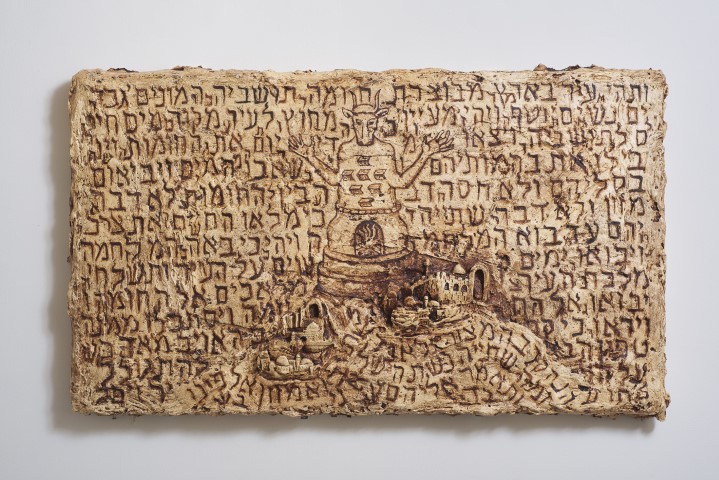
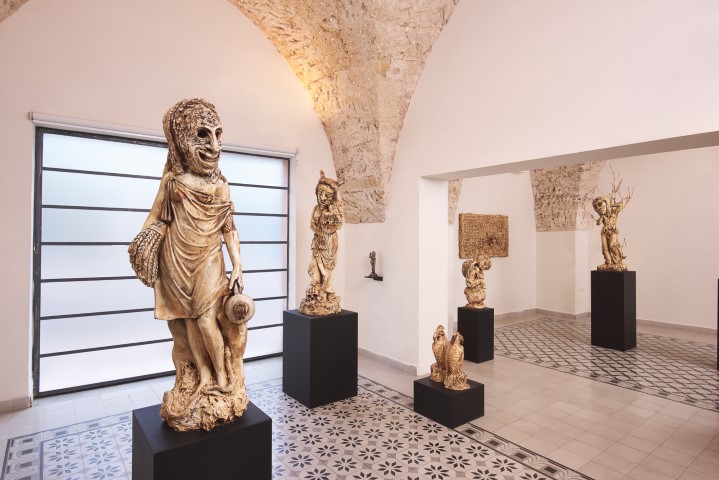
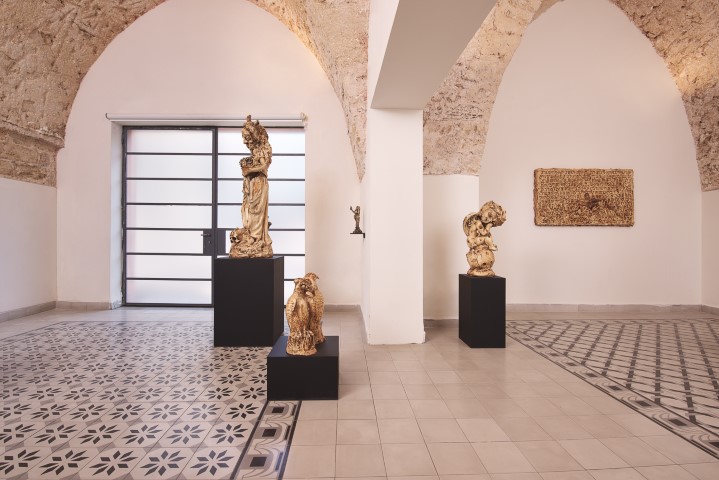

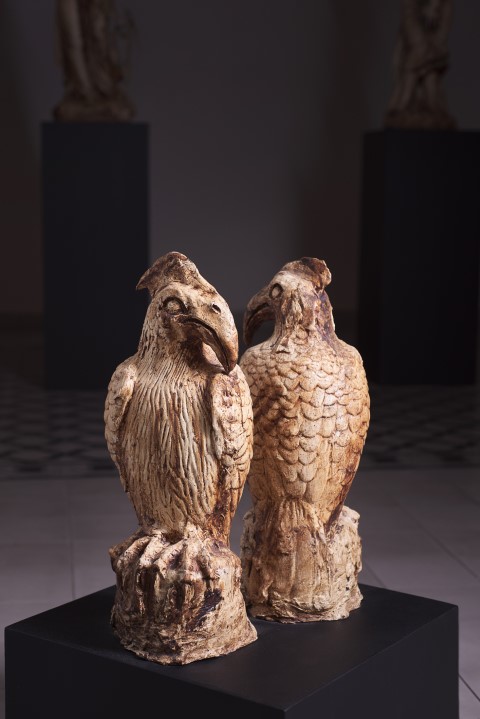
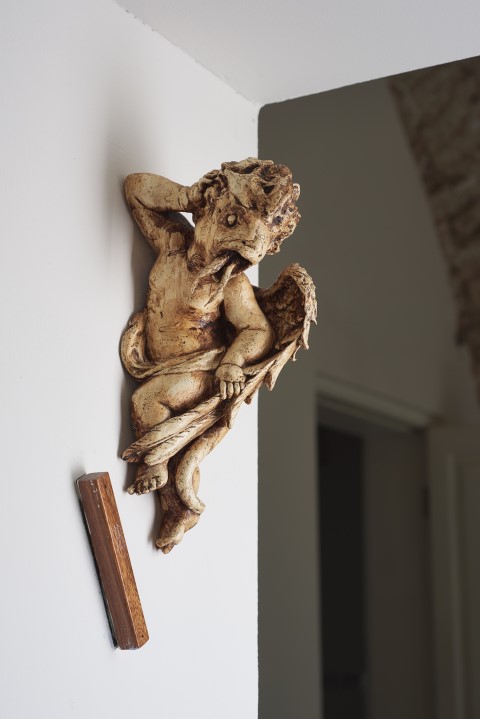









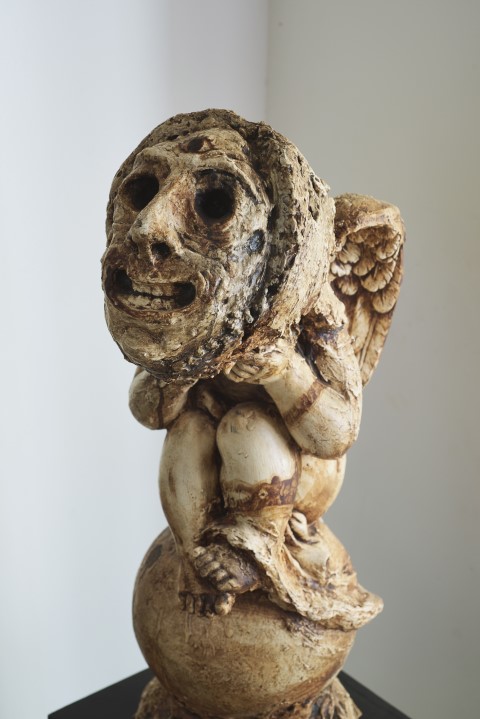

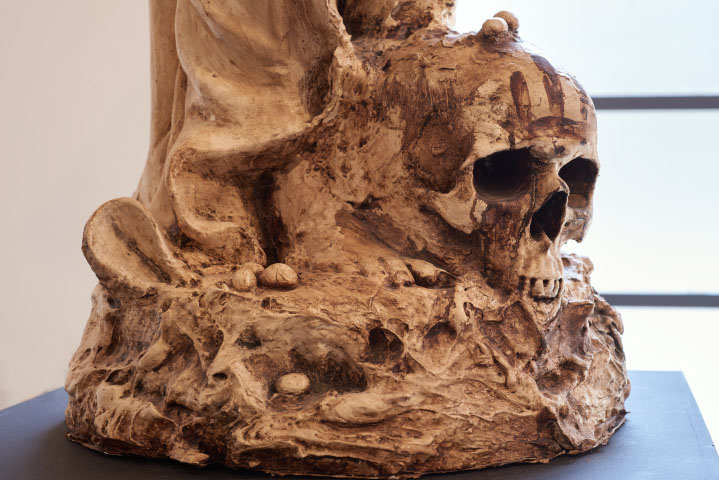
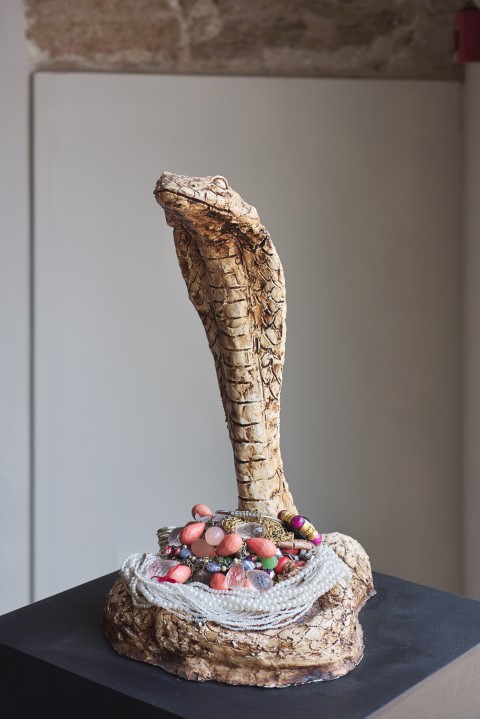

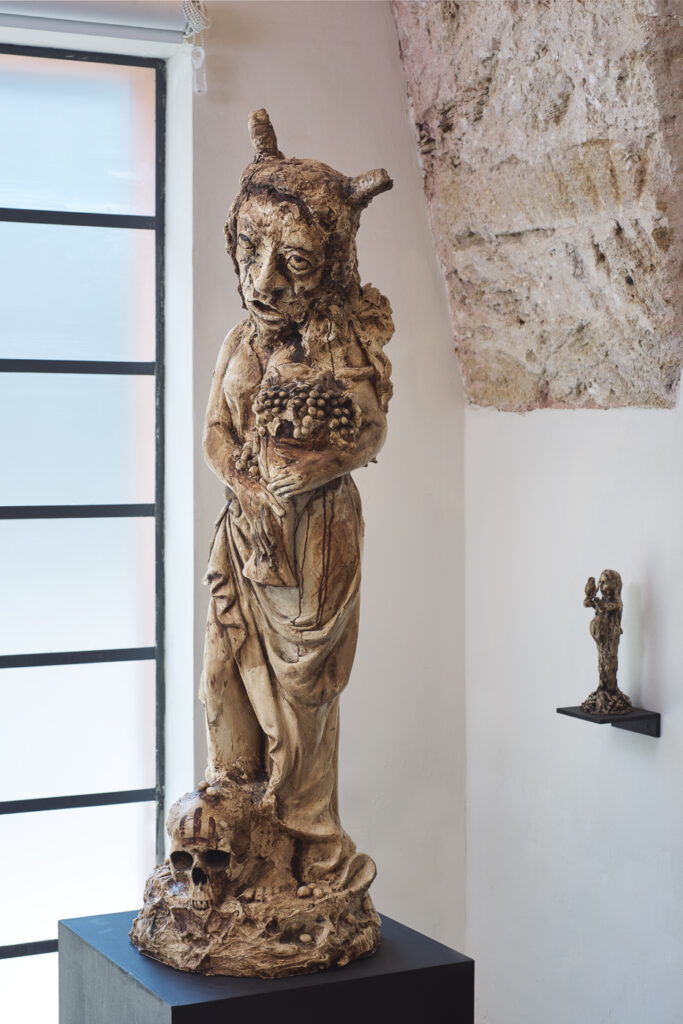
צילום: יובל חי
שירה פרידמן ואסי משולם – שיחה על התערוכה בכל המתנות בגלריה שכטר
בתערוכתו החדשה ממשיך משולם להתבסס על צדדים אפלים במיתולוגיה קדומה כדי ליצור חוויה אמנותית פולחנית ויצרית. האווירה הארכיאולוגית והאסתטיקה המטאליסטית מתאימות להפליא למגיפה התנ”כית בממדיה שבה אנו חיים.
מתוך מוסף גלריה של עיתון “הארץ”, אבי פיטשון, 18.11.20

